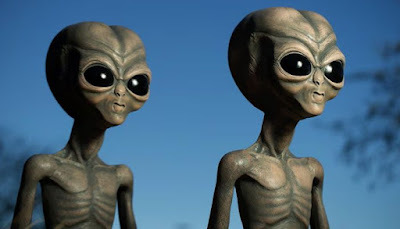Trey'von Knowles's Blog, page 15
May 25, 2025
Yes We Can Be Holy

Yes, We Can Be Holy
11 For the grace of God has appeared that offers salvation to all people. 12 It teaches us to say “No” to ungodliness and worldly passions, and to live self-controlled, upright and godly lives in this present age,
https://crosssides.blogspot.com/Song: America Cancel the Culture
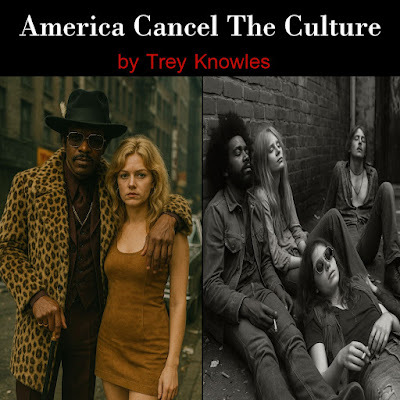
Trey Knowles' "America Cancel the Culture" is a powerful song that exposes the toxic elements of American culture and how they have harmed Black, Brown, and White communities—along with the broader global society. The lyrics portray America as a destructive force, a "beast" that manipulates and exploits minorities, causing deep psychological damage to countless lives around the world.
https://crosssides.blogspot.com/May 24, 2025
Project 2025 Completion Tracker

Project 2025 is a conservative policy initiative led by The Heritage Foundation, aiming to provide a blueprint for governance should a Republican administration take office in 2025. The checklist outlines key actions and policy shifts across various government departments, focusing on areas like economic policy, immigration, education, and federal administration.
The plan emphasizes reducing the size of the federal government, rolling back regulations, strengthening border security, and reshaping education policy to align with conservative principles. It also advocates for changes in leadership across federal agencies to ensure alignment with its agenda.
https://crosssides.blogspot.com/Song: Birth Defects
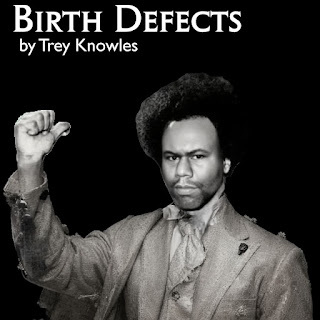
Trey Knowles’ “Birth Defects” explores how the enemy disrupts your path, striking at your foundation and placing obstacles meant to drain the life out of you. The song draws a powerful metaphor, showing that when people are abused, mistreated, or pushed out of their natural state of being, it causes deep emotional and psychological damage—likened to taking a wild animal from its natural habitat and forcing it into an unfamiliar, hostile environment.
https://crosssides.blogspot.com/May 23, 2025
The Gravitational Pull

Tides are primarily caused by the moon's gravitational pull on Earth's oceans, which creates bulges of water on both the side closest to and farthest from the moon. The sun's gravity also contributes to tides, but to a lesser extent. The moon's gravity is the main driver of tides, especially when the moon and sun are aligned, resulting in higher tides during full and new moons.
Here's a more detailed explanation:
1. The Moon's Gravitational Influence:
The Moon's gravity exerts a differential force on Earth, pulling water towards it and creating a bulge on the side of Earth closest to the Moon.
Because of inertia, water also bulges out on the opposite side of Earth, away from the Moon.
These bulges are the high tides, and the areas between them are the low tides.
2. The Sun's Influence:
The Sun also has a gravitational effect on Earth's tides, but it's less powerful than the Moon's due to the Moon's closer proximity.
The Sun's gravitational pull contributes to higher tides during full and new moons, when the Sun, Earth, and Moon are aligned.
3. Spring Tides:
When the Sun, Earth, and Moon are aligned (during full and new moons), their gravitational forces combine, leading to higher high tides and lower low tides, called spring tides.
Spring tides are typically 20% higher than normal and occur twice a month, coinciding with the full and new moons.
4. Neap Tides:
When the Sun, Earth, and Moon form a right angle (during the first and third quarter moons), their gravitational forces partially cancel each other out, resulting in lower high tides and higher low tides, called neap tides.
5. Other Factors:
The shape of the Earth's coastlines and the depth of the ocean also influence tide patterns.
Tidal friction between the Moon and Earth is also slowly slowing down Earth's rotation.
https://crosssides.blogspot.com/
HU in Human

Breaking down the word Human:
"Hu" can indeed refer to God, particularly in some spiritual and religious contexts. It's an ancient word found in various languages and traditions, often associated with divine presence, the divine utterance, or the sound of creation.
Ancient Egypt:
In ancient Egypt, "Hu" was the deification of the first word, the word of creation, uttered by the creator god Atum. It personified the creative utterance or the breath of God.
Sufism:
In Sufism, "Hu" is a pronoun used with Allah or God, meaning "He" or "Just He". It's also used in the shortened version of the Islamic creed, "There is no God but He".
General usage:
Many spiritual traditions recognize "Hu" as a sacred sound or syllable used in meditation, chanting, and prayer to connect with the divine.
Other connections:
The word "Hu" can also be found in other religious or mythological contexts, such as the Egyptian god Tehuti, the Mayan god Hunab Ku, and the Celtic god Hu.
https://crosssides.blogspot.com/Olmecs
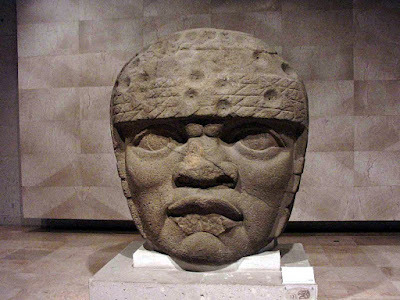
The Olmecs (/ˈɒlmɛks, ˈoʊl-/) or Olmec were an early known major Mesoamerican civilization, flourishing in the modern-day Mexican states of Veracruz and Tabasco from roughly 1200 to 400 BCE during Mesoamerica's formative period. They were initially centered at the site of their development in San Lorenzo Tenochtitlán, but moved to La Venta in the 10th century BCE following the decline of San Lorenzo. The Olmecs disappeared mysteriously in the 4th century BCE, leaving the region sparsely populated until the 19th century.
Among other "firsts", the Olmec appeared to practice ritual bloodletting and played the Mesoamerican ballgame, hallmarks of nearly all subsequent Mesoamerican societies. The aspect of the Olmecs most familiar now is their artwork, particularly the colossal heads. The Olmec civilization was first defined through artifacts which collectors purchased on the pre-Columbian art market in the late 19th and early 20th centuries. Olmec artworks are considered among ancient America's most striking.
Origins:
Pre-Olmec cultures had flourished since about 2500 BCE, and it has been speculated that the Olmecs derived in part from the neighboring Mokaya or Mixe–Zoque cultures which developed during this time. The beginnings of Olmec civilization have traditionally been placed between 1400 BCE and 1200 BCE. Past finds of Olmec remains ritually deposited at the shrine El Manatí near the triple archaeological sites known collectively as San Lorenzo Tenochtitlán moved this back to at least 1600–1500 BCE. It seems that the Olmec had their roots in early farming cultures of Tabasco, which began between 5100 BCE and 4600 BCE. These shared the same basic food crops and technologies of the later Olmec civilization.
What is today called Olmec first appeared fully within San Lorenzo Tenochtitlán, where distinctive Olmec features occurred around 1400 BCE. The rise of civilization was assisted by the local ecology of well-watered alluvial soil, as well as by the transportation network provided by the Coatzacoalcos river basin. This environment may be compared to that of other ancient centers of civilization such as the Nile, Indus, Yellow River and Mesopotamia. This highly productive environment encouraged a densely concentrated population, which in turn triggered the rise of an elite class.
The elite class created the demand for the production of the symbolic and sophisticated luxury artifacts that define Olmec culture. Many of these luxury artifacts were made from materials such as jade, obsidian, and magnetite, which came from distant locations and suggest that early Olmec elites had access to an extensive trading network in Mesoamerica. The source of the most valued jade was the Motagua River valley in eastern Guatemala, and Olmec obsidian has been traced to sources in the Guatemala highlands, such as El Chayal and San Martín Jilotepeque, or in Puebla, distances ranging from 200 to 400 km (120–250 miles) away, respectively.
1530 BCE.
https://crosssides.blogspot.com/Mansa Musa
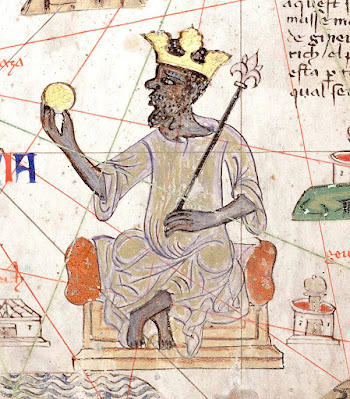
Mansa Musa (reigned c. 1312 – c. 1337) was the ninth Mansa of the Mali Empire, which reached its territorial peak during his reign. Musa's reign is often regarded as the zenith of Mali's power and prestige, although he features less in Mandinka oral traditions than his predecessors.
He was exceptionally wealthy to an extent that he was described as being inconceivably rich by contemporaries; Time magazine reported: "There's really no way to put an accurate number on his wealth." It is known from local manuscripts and travellers' accounts that Mansa Musa's wealth came principally from the Mali Empire's control and taxing of the trade in salt from northern regions and especially from gold panned and mined in Bambuk and Bure to the south. Over a very long period Mali had amassed a large reserve of gold. Mali is also believed to have been involved in the trade in many goods such as ivory, slaves, spices, silks, and ceramics. However, presently little is known about the extent or mechanics of these trades. At the time of Musa's ascension to the throne, Mali consisted largely of the territory of the former Ghana Empire, which had become a vassal of Mali. The Mali Empire comprised land that is now part of Guinea, Senegal, Mauritania, the Gambia, and the modern state of Mali.
Musa went on Hajj to Mecca in 1324, traveling with an enormous entourage and a vast supply of gold. En route he spent time in Cairo, where his lavish gift-giving is said to have noticeably affected the value of gold in Egypt and garnered the attention of the wider Muslim world. Musa expanded the borders of the Mali Empire, in particular incorporating the cities of Gao and Timbuktu into its territory. He sought closer ties with the rest of the Muslim world, particularly the Mamluk and Marinid Sultanates. He recruited scholars from the wider Muslim world to travel to Mali, such as the Andalusian poet Abu Ishaq al-Sahili, and helped establish Timbuktu as a center of Islamic learning. His reign is associated with numerous construction projects, including a portion of Djinguereber Mosque in Timbuktu.
Mansa Musa's personal name was Musa (Arabic: موسى, romanized: Mūsá), the name of Moses in Islam. Mansa, 'ruler' or 'king' in Mandé, was the title of the ruler of the Mali Empire.
In oral tradition and the Timbuktu Chronicles, Musa is further known as Kanku Musa. In Mandé tradition, it was common for one's name to be prefixed by his mother's name, so the name Kanku Musa means "Musa, son of Kanku", although it is unclear whether the genealogy implied is literal. Al-Yafii gave Musa's name as Musa ibn Abi Bakr ibn Abi al-Aswad (Arabic: موسى بن أبي بكر بن أبي الأسود, romanized: Mūsā ibn Abī Bakr ibn Abī al-Aswad), and ibn Hajar gave Musa's name as Musa ibn Abi Bakr Salim al-Takruri (Arabic: موسى بن أبي بكر سالم التكروري, romanized: Mūsā ibn Abī Bakr Salim al-Takruri).
Musa is often given the title Hajji in oral tradition because he made hajj. In the Songhai language, rulers of Mali such as Musa were known as the Mali-koi, koi being a title that conveyed authority over a region: in other words, the "ruler of Mali".
Pilgrimage to Mecca:
Musa was a Muslim, and his hajj, or pilgrimage to Mecca, made him well known across North Africa and the Middle East. To Musa, Islam was "an entry into the cultured world of the Eastern Mediterranean". He would have spent much time fostering the growth of the religion within his empire. When Musa departed Mali for the Hajj, he left his son Muhammad to rule in his absence.
Musa made his pilgrimage between 1324 and 1325, spanning 2700 miles. His procession reportedly included upwards of 12,000 slaves, all wearing brocade and Yemeni silk and each carrying 1.8 kg (4 lb) of gold bars, with heralds dressed in silks bearing gold staffs organizing horses and handling bags.[citation needed]
Musa provided all necessities for the procession, feeding the entire company of men and animals. Those animals included 80 camels, which each carried 23–136 kg (50–300 lb) of gold dust. Musa gave the gold to the poor he met along his route. Musa not only gave to the cities he passed on the way to Mecca, including Cairo and Medina, but also traded gold for souvenirs. It was reported that he built a mosque every Friday. Shihab al-Din al-'Umari, who visited Cairo shortly after Musa's pilgrimage to Mecca, noted that it was "a lavish display of power, wealth, and unprecedented by its size and pageantry".[51] Musa made a major point of showing off his nation's wealth.
Musa and his entourage arrived at the outskirts of Cairo in July 1324. They camped for three days by the Pyramids of Giza before crossing the Nile into Cairo on 19 July. While in Cairo, Musa met with the Mamluk sultan al-Nasir Muhammad, whose reign had already seen one mansa, Sakura, make the Hajj. Al-Nasir expected Musa to prostrate himself before him, which Musa initially refused to do. When Musa did finally bow he said he was doing so for God alone.
Despite this initial awkwardness, the two rulers got along well and exchanged gifts. Musa and his entourage gave and spent freely while in Cairo. Musa stayed in the Qarafa district of Cairo and befriended its governor, ibn Amir Hajib, who learned much about Mali from him. Musa stayed in Cairo for three months, departing on 18 October with the official caravan to Mecca.
Musa's generosity continued as he traveled onward to Mecca, and he gave gifts to fellow pilgrims and the people of Medina and Mecca. While in Mecca, conflict broke out between a group of Malian pilgrims and a group of Turkic pilgrims in the Masjid al-Haram. Swords were drawn, but before the situation escalated further, Musa persuaded his men to back down.
Musa and his entourage lingered in Mecca after the last day of the Hajj. Traveling separately from the main caravan, their return journey to Cairo was struck by catastrophe. By the time they reached Suez, many of the Malian pilgrims had died of cold, starvation, or bandit raids, and they had lost much of their supplies.
Having run out of money, Musa and his entourage were forced to borrow money and resell much of what they had purchased while in Cairo before the Hajj, and Musa went into debt to several merchants such as Siraj al-Din. However, Al-Nasir Muhammad returned Musa's earlier show of generosity with gifts of his own.
On his return journey, Musa met the Andalusi poet Abu Ishaq al-Sahili, whose eloquence and knowledge of jurisprudence impressed him, and whom he convinced to travel with him to Mali. Other scholars Musa brought to Mali included Maliki jurists.
According to the Tarikh al-Sudan, the cities of Gao and Timbuktu submitted to Musa's rule as he traveled through on his return to Mali. It is unlikely, however, that a group of pilgrims, even if armed, would have been able to conquer a wealthy and powerful city. According to one account given by ibn Khaldun, Musa's general Saghmanja conquered Gao. The other account claims that Gao had been conquered during the reign of Mansa Sakura. Mali's control of Gao may have been weak, requiring powerful mansas to reassert their authority periodically, or it might simply be an error on the part of al-Sadi, author of the Tarikh.
https://crosssides.blogspot.com/Song: I Face Death Every Day
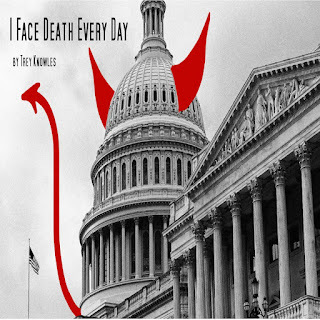
Trey Knowles’ “I Face Death Every Day” is a powerful reflection on the dangers and delusions of modern life. It challenges us to examine what we consume—both mentally and physically—what we pursue, and why we willingly risk our well-being. Living under the spell of a corrupt system, the song questions whether this path aligns with any divine purpose.
May 21, 2025
intergalactic War
An intergalactic war refers to a hypothetical conflict between civilizations from different galaxies, a concept commonly explored in science fiction. It's distinct from interstellar war, which involves conflicts between systems within the same galaxy, and interplanetary war, which occurs between planets within the same planetary system.
Key aspects of intergalactic war in a sci-fi context:
Space Opera Genre:
The concept of intergalactic war is a popular plot device in the space opera subgenre of science fiction, often featuring large-scale space battles and exploration of different alien cultures.
Inter-galaxy Conflict:
Intergalactic war, in a sci-fi context, implies a conflict between civilizations that inhabit different galaxies, potentially involving vast distances, complex political landscapes, and diverse technological capabilities.
